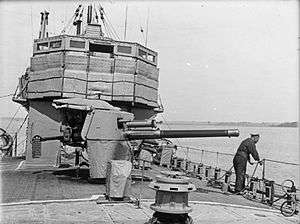HMS Satyr (1916)
HMS Satyr was an R-class destroyer which served with the Royal Navy. She was launched on 27 December 1916 and sold to be broken up on 16 December 1926.[1]
 HMS Satyr in 1918 at Harwich where she was stationed | |
| History | |
|---|---|
| Name: | HMS Satyr |
| Builder: | William Beardmore and Company, Dalmuir |
| Launched: | 27 December 1916 |
| Fate: | Sold, 16 December 1926 |
| General characteristics | |
| Class and type: | R-class destroyer |
| Displacement: | 975 long tons (991 t) normal |
| Length: | 276 ft (84.1 m) |
| Beam: | 26 ft 6 in (8.1 m) |
| Draught: | 9 ft (2.7 m) |
| Propulsion: |
|
| Speed: | 36 knots (41.4 mph; 66.7 km/h) |
| Range: | 3,440 nmi (6,370 km) at 15 kn (28 km/h) |
| Complement: | 82 |
| Armament: |
|
Construction
Satyr was one of ten R-class destroyers ordered by the British Admiralty in December 1915 as part of the Seventh War Construction Programme. The ship was laid down at the William Beardmore and Company shipyard in Dalmuir during April 1916, launched in December 1916 and completed in February 1917.[2]
Satyr was 276 feet (84.12 m) long overall, with a beam of 26 feet 6 inches (8.08 m) and a draught of 9 feet (2.74 m).[3] Displacement was 975 long tons (991 t) normal and 1,075 long tons (1,092 t) deep load. Power was provided by three Yarrow boilers feeding two Parsons geared steam turbines rated at 27,000 shaft horsepower (20,000 kW) and driving two shafts, to give a design speed of 36 knots (67 km/h; 41 mph).[3] Three funnels were fitted. 296 long tons (301 t) of oil were carried, giving a design range of 3,450 nautical miles (6,390 km; 3,970 mi) at 15 knots (28 km/h; 17 mph).[2]
Armament consisted of three QF 4in Mk IV guns on the ship's centreline, with one on the forecastle, one aft on a raised platform and one between the second and third funnels. A single 2-pounder (40 mm) pom-pom anti-aircraft gun was carried, while torpedo armament consisted of two twin mounts for 21 in (533 mm) torpedoes.[3] Fire control included a single Dumaresq and a Vickers range clock.[4] The ship had a complement of 82 officers and men.[3]
Service
On commissioning, Satyr joined the 10th Destroyer Flotilla of the Harwich Force.[5] The commanding officer was Commander Hubert de Burgh.[6]
On 4 June 1917, Satyr was deployed as part of a large group of 7 cruisers and 25 destroyers to protect the monitors Erebus and Terror in their bombardment of the German held Belgian port of Ostend. Along with Taurus, Sharpshooter and Torrent, Satyr sank the German destroyer S20. De Burgh received the DSO for his part in the action, particularly for saving the lives of seven of the crew of S20 while under fire.[6]
Satyr remained part of the 10th Destroyer Flotilla at the end of the war,[8] but by February 1919, had been transferred to the Torpedo School at the Devonport.[9] The destroyer was sold for scrap to Ward of Milford Haven on 16 December 1926.[3]

Pennant numbers
| Pennant Number | Date |
|---|---|
| F51 | January 1917[10] |
| F59 | January 1918[10] |
References
- "Admiralty R-class destroyers (1915-1917)". Royal-Navy.org. Archived from the original on 3 December 2013. Retrieved 22 April 2017.
- Friedman, Norman (2009). British Destroyers: From Earliest Days to the First World War. Barnsley: Seaforth Publishing. p. 310. ISBN 978-1-84832-049-9.
- Gardiner, Robert; Gray, Randal, eds. (1985). Conway's All the World's Fighting Ships 1906–1921. London: Conway Maritime Press. p. 81. ISBN 0-85177-245-5.
- "Fire Control in H.M. Ships". The Technical History and Index: Alteration in Armaments of H.M. Ships during the War. 3 (23): 31. 1919.
- "Supplement to the Navy List Showing Organisation of the Fleet, Flag Officers' Commands &c.: II — Harwich Force". The Navy List: 13. January 1917. Retrieved 22 April 2017.
- Dunn, Steve (2017). Securing the Narrow Sea: The Dover Patrol 1914 - 1918. Barnsley: Seaforth Publishing. p. 167.
- "Supplement to the Navy List Showing Organisation of the Fleet, Flag Officers' Commands &c.: II.–Harwich Force". The Navy List: 13. December 1918. Retrieved 22 April 2017.
- "Supplement to the Monthly Navy List Showing Organisation of the Fleet, Flag Officers' Commands &c.: VI.–Local Defence and Minesweeping Flotillas and Training Establishments". The Navy List: 17. February 1919. Retrieved 22 April 2017.
- Dittmar, F.J.; Colledge, J.J. (1972). British Warships 1914–1919. Shepperton: Ian Allan. p. 71. ISBN 0-7110-0380-7.
Bibliography
- Colledge, J. J.; Warlow, Ben (2006) [1969]. Ships of the Royal Navy: The Complete Record of all Fighting Ships of the Royal Navy (Rev. ed.). London: Chatham Publishing. ISBN 978-1-86176-281-8.
- Friedman, Norman (2009). British Destroyers: From Earliest Days to the Second World War. Barnsley, UK: Seaforth Publishing. ISBN 978-1-84832-049-9.
- Gardiner, Robert & Gray, Randal, eds. (1985). Conway's All The World's Fighting Ships 1906–1921. London: Conway Maritime Press. ISBN 0-85177-245-5.
- March, Edgar J. (1966). British Destroyers: A History of Development, 1892–1953; Drawn by Admiralty Permission From Official Records & Returns, Ships' Covers & Building Plans. London: Seeley Service. OCLC 164893555.